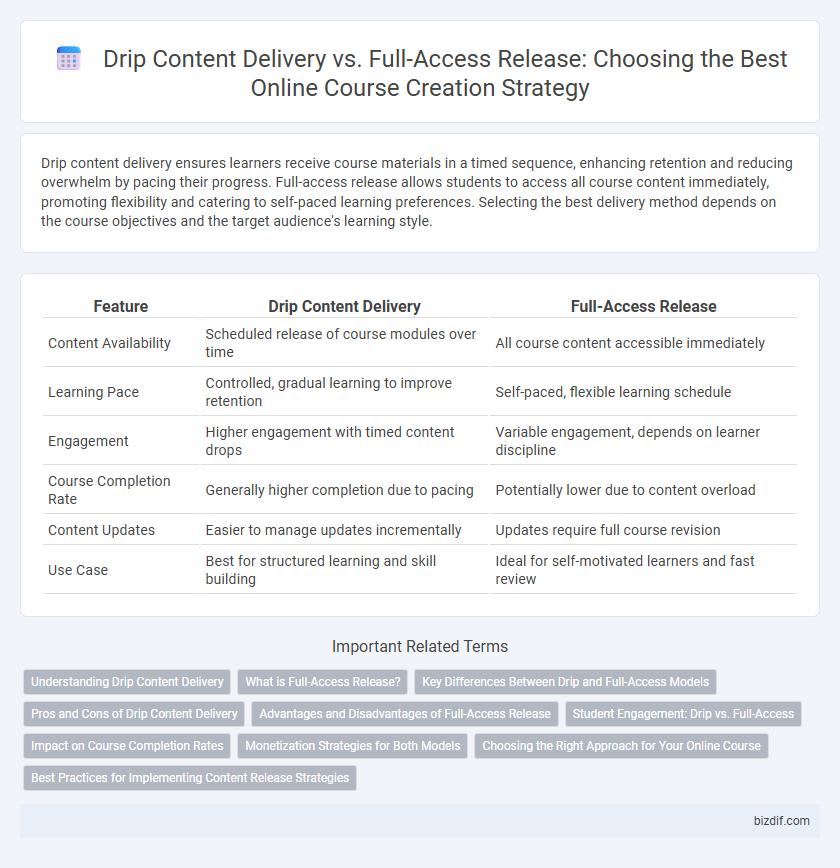Drip content delivery ensures learners receive course materials in a timed sequence, enhancing retention and reducing overwhelm by pacing their progress. Full-access release allows students to access all course content immediately, promoting flexibility and catering to self-paced learning preferences. Selecting the best delivery method depends on the course objectives and the target audience's learning style.
Table of Comparison
| Feature | Drip Content Delivery | Full-Access Release |
|---|---|---|
| Content Availability | Scheduled release of course modules over time | All course content accessible immediately |
| Learning Pace | Controlled, gradual learning to improve retention | Self-paced, flexible learning schedule |
| Engagement | Higher engagement with timed content drops | Variable engagement, depends on learner discipline |
| Course Completion Rate | Generally higher completion due to pacing | Potentially lower due to content overload |
| Content Updates | Easier to manage updates incrementally | Updates require full course revision |
| Use Case | Best for structured learning and skill building | Ideal for self-motivated learners and fast review |
Understanding Drip Content Delivery
Drip content delivery schedules course materials to release incrementally over time, enhancing learner retention and motivation by preventing content overload. This method allows educators to control the pacing, ensuring students fully absorb one module before progressing to the next. Data shows drip-fed courses often improve completion rates compared to full-access releases where all materials are available immediately.
What is Full-Access Release?
Full-access release in online course creation allows students to access all course materials instantly upon enrollment, enabling self-paced learning and immediate deep dives into the content. This model supports flexible scheduling and rapid skill acquisition, catering to learners who prefer autonomous progress. Platforms offering full-access release often report higher initial engagement rates, as students can tailor their study time according to personal availability and motivation.
Key Differences Between Drip and Full-Access Models
Drip content delivery releases course materials incrementally based on a schedule, enhancing student engagement and preventing overwhelm by pacing content consumption. Full-access release grants immediate access to all course modules, allowing learners to progress at their own speed but potentially causing information overload. Key differences include control over learning pace, student motivation, and content retention strategies, making drip models ideal for structured learning and full-access models suited for flexible, self-directed study.
Pros and Cons of Drip Content Delivery
Drip content delivery schedules course materials to students incrementally, enhancing retention by preventing information overload and encouraging consistent engagement. This method fosters disciplined learning habits and allows instructors to monitor progress closely, but it may frustrate self-paced learners who prefer immediate access to all materials. The structured release can improve content absorption but limits flexibility, potentially reducing satisfaction among students seeking rapid completion.
Advantages and Disadvantages of Full-Access Release
Full-access release provides students immediate availability of all course materials, enhancing flexibility and self-paced learning, which can improve user satisfaction and course completion rates. However, this method may overwhelm learners with too much content at once, reducing focus and potentially leading to lower engagement and retention. Instructors lose the opportunity to strategically guide learning progression, which can impact knowledge absorption and the overall educational experience.
Student Engagement: Drip vs. Full-Access
Drip content delivery enhances student engagement by pacing the learning process, encouraging consistent interaction and reducing overwhelm. Full-access release allows learners to progress at their own speed, benefiting self-motivated students but risking disengagement for others due to content overload. Effective course design aligns content delivery with learner preferences to maximize retention and active participation.
Impact on Course Completion Rates
Drip content delivery enhances course completion rates by providing learners with manageable, scheduled lessons that prevent overwhelm and maintain consistent engagement. In contrast, full-access release often leads to lower completion rates due to information overload and procrastination. Structured pacing in drip delivery supports sustained motivation and better knowledge retention for online courses.
Monetization Strategies for Both Models
Drip content delivery enhances monetization by encouraging sustained subscriber engagement and reducing churn through scheduled release of course modules, which fosters anticipation and perceived value. Full-access release maximizes upfront revenue and appeals to learners seeking immediate gratification, but may require additional marketing efforts to re-engage users post-purchase. Both models benefit from strategic pricing, upselling complementary products, and leveraging subscription or one-time payment options tailored to target audience preferences.
Choosing the Right Approach for Your Online Course
Drip content delivery gradually releases course material over a set schedule, fostering engagement and preventing overwhelm, while full-access release allows students immediate access to all content, supporting self-paced learning. Selecting the right approach depends on factors like course complexity, student motivation levels, and desired learning outcomes. Analyzing target audience preferences and course structure ensures an optimized online course experience that maximizes retention and completion rates.
Best Practices for Implementing Content Release Strategies
Drip content delivery enhances learner engagement by providing modules incrementally, promoting better retention and reducing overwhelm, which aligns with cognitive load theory. Full-access release caters to self-paced learners, encouraging autonomy but requires strong course structure and clear guidance to prevent confusion. Best practices include aligning release strategies with learner goals, using analytics to monitor progress, and balancing pacing with flexibility for optimal knowledge absorption.
Drip content delivery vs Full-access release Infographic

 bizdif.com
bizdif.com